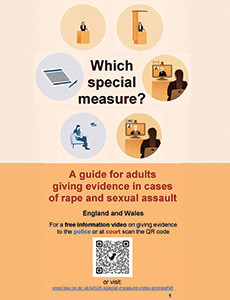*/

Which special measure? Dr Natalie Kyneswood discusses the accessible resources she has produced for adult-victim witnesses in sex offence cases to explain how special measures work
The idea of creating a video and leaflet, which would explicate the different ways of giving evidence to the police and at court, developed out of my doctoral research investigating the s 28 pilot for ‘intimidated witnesses’ in sex offence cases – hereafter ‘intimidated complainants’ – adult victim-witnesses in sex offence cases who are presumed eligible to apply for special measures, including s 28, by virtue of the nature of the offence (s 17(4) YJCEA 1999).
RASSO (rape and serious sexual offences) practitioners will be aware that s 28 was originally piloted for ‘vulnerable witnesses’ – i.e., witnesses in all cases who qualified on the grounds of age or incapacity under s 16(1)(2) of the YJCEA 1999 – while the second s 28 pilot for intimidated complainants in sex offence cases did not commence until June 2019. As part of my study, I observed some of the first s 28 hearings and s 28 trials involving intimidated complainants and interviewed barristers instructed in those cases.
During the pilot, it was evident that there was confusion among police, caseworkers, barristers and judges regarding intimidated complainants’ eligibility for s 28. This was due to a lack of awareness about the second s 28 pilot and difficulty distinguishing between ‘vulnerable’ and ‘intimidated’ adult witnesses in sex offence cases. Consequently, intimidated complainants were not routinely informed of their eligibility to apply for s 28 in cases observed, which resulted in judges adjourning special measure applications for checks to be made.
Since then, s 28 has been rolled out for intimidated complainants at all Crown Courts nationwide. Yet, evidence recently submitted to the Justice Select Committee’s Inquiry on The Use of Pre-recorded Cross-examination suggests that intimidated complainants may still be receiving inaccurate information about s 28. Hence, the resources were devised, in part, to clarify the key measures that all adult complainants in sex offence cases are now eligible for. Special measures featured in the video and leaflet comprise: the video recorded police interview; screens; live link; and pre-recorded cross-examination. They do not refer to intermediaries, for example, which are exclusively for vulnerable witnesses, nor do they cover ground rules hearings (GRHs), which are also associated with vulnerable witnesses. Although GRHs are an inherent part of the s 28 procedure for young or vulnerable witnesses, my research indicates that they are used sporadically in s 28 cases involving intimidated complainants and are different in scope.
Nevertheless, the resources do tackle some of the legal uncertainties and logistical challenges of applying for special measures, particularly pre-recorded cross-examination. As with all special measures, s 28 is not available automatically for intimidated complainants (though the Law Commission has proposed reforming the law in this regard). However, unlike screens or live link, there are many more factors which may impede intimidated complainants’ access to s 28 in practice, including issues with court listings. Therefore, the video elucidates that s 28 may sometimes be more difficult to apply for than other special measures because it takes place before trial and can be more difficult to organise. The video also helps manage witnesses’ expectations by demonstrating how special measures operate in the courtroom, using labels, sightlines and animation to bring them to life. This is significant because witnesses may not have the opportunity to try the equipment or see the courtroom beforehand.
The resources are necessary to disseminate timely and consistent information about special measures because the advent of s 28 requires intimidated complainants to make earlier, more definitive decisions about how they would prefer to testify. Rather than waiting until the day of trial, complainants must now think about the prospect of cross-examination almost at the time of reporting, since eligibility for s 28 is dependent on video recording the police interview. Consequently, although the guides explain the order of giving evidence, they also stress the link between the police and the court stage; that the way evidence is given to the police affects the options available later at court, if the case goes to trial. The video and leaflet are also freely available to view or download online, at any time, and are produced in an easily digestible format, recognising that complainants may still be in shock or highly emotional when accessing the resources. The benefits of having a video, which is approximately 15 minutes long, is that it can be paused and replayed. The benefits of having a leaflet, in addition to the video, is that it provides an alternative means of accessing key information, reinforces the points in the video, and contains a glossary of terms.
My research is not alone in finding that intimidated complainants may be expected to give evidence a certain way or find themselves unduly influenced by police officers, prosecutors, or court supporters’ ideas about there being a ‘preferred mode of testimony’. In designing the resources, I have endeavoured to provide balanced information to help intimidated complainants make independent and informed decisions about giving evidence. Emphasising that each mode of testimony has its drawbacks, as well as its advantages, was the most controversial aspect of the video and leaflet among those I consulted during the design cycle. Nonetheless, common concerns about using special measures are raised and discussed, e.g., the fear of being seen by the defendant or the public in open court or on TV monitors; the prospect of combining screens and s 28 or ‘screening the screen’; and issues affecting the quality of pre-recorded evidence presented in court. Additionally, the video and leaflet expressly state that intimidated complainants do not have to use special measures unless they want to, and some of the pros and cons of providing a witness statement and testifying from the witness box without screens are also explored.
The process of making the resources took nine months and involved input from policy makers, judges, barristers and independent sexual violence advisers (ISVAs), who tried and tested earlier versions of the video and leaflet and provided invaluable feedback on their contents and style. However, while the finished products are evidence-based and contain important caveats, they cannot cover every special measure or eventuality. Rather, I hope that they might prove a useful starting point or discussion aid for police, legal professions, ISVAs and court supporters when initiating special measures conversations with intimidated complainants.


The idea of creating a video and leaflet, which would explicate the different ways of giving evidence to the police and at court, developed out of my doctoral research investigating the s 28 pilot for ‘intimidated witnesses’ in sex offence cases – hereafter ‘intimidated complainants’ – adult victim-witnesses in sex offence cases who are presumed eligible to apply for special measures, including s 28, by virtue of the nature of the offence (s 17(4) YJCEA 1999).
RASSO (rape and serious sexual offences) practitioners will be aware that s 28 was originally piloted for ‘vulnerable witnesses’ – i.e., witnesses in all cases who qualified on the grounds of age or incapacity under s 16(1)(2) of the YJCEA 1999 – while the second s 28 pilot for intimidated complainants in sex offence cases did not commence until June 2019. As part of my study, I observed some of the first s 28 hearings and s 28 trials involving intimidated complainants and interviewed barristers instructed in those cases.
During the pilot, it was evident that there was confusion among police, caseworkers, barristers and judges regarding intimidated complainants’ eligibility for s 28. This was due to a lack of awareness about the second s 28 pilot and difficulty distinguishing between ‘vulnerable’ and ‘intimidated’ adult witnesses in sex offence cases. Consequently, intimidated complainants were not routinely informed of their eligibility to apply for s 28 in cases observed, which resulted in judges adjourning special measure applications for checks to be made.
Since then, s 28 has been rolled out for intimidated complainants at all Crown Courts nationwide. Yet, evidence recently submitted to the Justice Select Committee’s Inquiry on The Use of Pre-recorded Cross-examination suggests that intimidated complainants may still be receiving inaccurate information about s 28. Hence, the resources were devised, in part, to clarify the key measures that all adult complainants in sex offence cases are now eligible for. Special measures featured in the video and leaflet comprise: the video recorded police interview; screens; live link; and pre-recorded cross-examination. They do not refer to intermediaries, for example, which are exclusively for vulnerable witnesses, nor do they cover ground rules hearings (GRHs), which are also associated with vulnerable witnesses. Although GRHs are an inherent part of the s 28 procedure for young or vulnerable witnesses, my research indicates that they are used sporadically in s 28 cases involving intimidated complainants and are different in scope.
Nevertheless, the resources do tackle some of the legal uncertainties and logistical challenges of applying for special measures, particularly pre-recorded cross-examination. As with all special measures, s 28 is not available automatically for intimidated complainants (though the Law Commission has proposed reforming the law in this regard). However, unlike screens or live link, there are many more factors which may impede intimidated complainants’ access to s 28 in practice, including issues with court listings. Therefore, the video elucidates that s 28 may sometimes be more difficult to apply for than other special measures because it takes place before trial and can be more difficult to organise. The video also helps manage witnesses’ expectations by demonstrating how special measures operate in the courtroom, using labels, sightlines and animation to bring them to life. This is significant because witnesses may not have the opportunity to try the equipment or see the courtroom beforehand.
The resources are necessary to disseminate timely and consistent information about special measures because the advent of s 28 requires intimidated complainants to make earlier, more definitive decisions about how they would prefer to testify. Rather than waiting until the day of trial, complainants must now think about the prospect of cross-examination almost at the time of reporting, since eligibility for s 28 is dependent on video recording the police interview. Consequently, although the guides explain the order of giving evidence, they also stress the link between the police and the court stage; that the way evidence is given to the police affects the options available later at court, if the case goes to trial. The video and leaflet are also freely available to view or download online, at any time, and are produced in an easily digestible format, recognising that complainants may still be in shock or highly emotional when accessing the resources. The benefits of having a video, which is approximately 15 minutes long, is that it can be paused and replayed. The benefits of having a leaflet, in addition to the video, is that it provides an alternative means of accessing key information, reinforces the points in the video, and contains a glossary of terms.
My research is not alone in finding that intimidated complainants may be expected to give evidence a certain way or find themselves unduly influenced by police officers, prosecutors, or court supporters’ ideas about there being a ‘preferred mode of testimony’. In designing the resources, I have endeavoured to provide balanced information to help intimidated complainants make independent and informed decisions about giving evidence. Emphasising that each mode of testimony has its drawbacks, as well as its advantages, was the most controversial aspect of the video and leaflet among those I consulted during the design cycle. Nonetheless, common concerns about using special measures are raised and discussed, e.g., the fear of being seen by the defendant or the public in open court or on TV monitors; the prospect of combining screens and s 28 or ‘screening the screen’; and issues affecting the quality of pre-recorded evidence presented in court. Additionally, the video and leaflet expressly state that intimidated complainants do not have to use special measures unless they want to, and some of the pros and cons of providing a witness statement and testifying from the witness box without screens are also explored.
The process of making the resources took nine months and involved input from policy makers, judges, barristers and independent sexual violence advisers (ISVAs), who tried and tested earlier versions of the video and leaflet and provided invaluable feedback on their contents and style. However, while the finished products are evidence-based and contain important caveats, they cannot cover every special measure or eventuality. Rather, I hope that they might prove a useful starting point or discussion aid for police, legal professions, ISVAs and court supporters when initiating special measures conversations with intimidated complainants.

Which special measure? Dr Natalie Kyneswood discusses the accessible resources she has produced for adult-victim witnesses in sex offence cases to explain how special measures work


Now is the time to tackle inappropriate behaviour at the Bar as well as extend our reach and collaboration with organisations and individuals at home and abroad
A comparison – Dan Monaghan, Head of DWF Chambers, invites two viewpoints
And if not, why not? asks Louise Crush of Westgate Wealth Management
Marie Law, Head of Toxicology at AlphaBiolabs, discusses the many benefits of oral fluid drug testing for child welfare and protection matters
To mark International Women’s Day, Louise Crush of Westgate Wealth Management looks at how financial planning can help bridge the gap
Casey Randall of AlphaBiolabs answers some of the most common questions regarding relationship DNA testing for court
Maria Scotland and Niamh Wilkie report from the Bar Council’s 2024 visit to the United Arab Emirates exploring practice development opportunities for the England and Wales family Bar
Marking Neurodiversity Week 2025, an anonymous barrister shares the revelations and emotions from a mid-career diagnosis with a view to encouraging others to find out more
David Wurtzel analyses the outcome of the 2024 silk competition and how it compares with previous years, revealing some striking trends and home truths for the profession
Save for some high-flyers and those who can become commercial arbitrators, it is generally a question of all or nothing but that does not mean moving from hero to zero, says Andrew Hillier